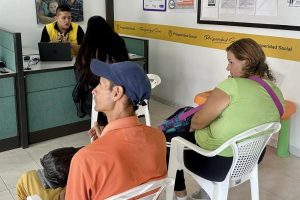() — President Joe Biden officially announced his student loan forgiveness plan, but many questions remain, including: Exactly how much will it cost? Will it add to inflation? Does Biden have the authority to pick up a pen and make this happen?
But the top question for many people who didn’t go to college, those who have already paid off their loans, or people who earn more than $125,000 (or more than $250,000 if they are married couples or heads of households) is this: What what about me?
People who are interested in buying an electric vehicle with the help of a federal tax credit but earn more than $150,000 ($300,000 if married) are wondering the same thing.
Universal proposals are a thing of the past
It’s a 180-degree turn in the national conversation since the 2020 presidential campaign when serious candidates like Andrew Yang were pushing the idea of a universal basic income for all Americans — the idea that every American adult should get a check payment of $1,000 a month–regardless of your income, and Senator Cory Booker of New Jersey was pushing for “baby bonuses” to be given to nearly all American children to address racial inequality.
Income limits, or means testing, is how the government directs help to people who really need it.
It also creates new layers of government bureaucracy to verify income and can lead to complaints about injustice and stigma. More on that below.
Inflation fears are real
There are also valid concerns that funneling all this cash into the economy (it will be hundreds of billions of dollars, but we don’t know exactly how much) will only add to the runaway inflation that has made life for Americans so much more expensive.
“We need to make college affordable, not send a $10,000 gift to people who already have, in many cases, advanced degrees,” Marc Goldwein, senior policy director for the Committee for a Responsible Federal Budget, said during an interview. with ‘s Poppy Harlow before the loan forgiveness was formally announced.
The biggest problem is the cost of college education
Goldwein argued that targeting people with college loans is unfair to people who aren’t going to college or pursuing advanced degrees.
“Student debt is disproportionately held by people who have advanced degrees and a good income, and can afford it much more than ordinary Americans who see the cost of gas and clothing rise,” Goldwein said.
Not Everyone With College Debt Finishes College
Indivar Dutta-Gupta of the Center for Law and Social Policy agrees that college affordability is a larger issue that needs to be addressed. But he reacted during our phone conversation when I said that the Biden program focuses on people who have degrees and earning potential.
“A lot of them don’t have titles,” he said. “About 40% of people with student debt don’t have a college degree. That’s something people don’t realize.”
There is overlap, he said, between people in poverty and people who have attended college. His concern is that the income limit creates barriers to getting help to people who may have a hard time proving their income.
$125,000 isn’t that much in some places
It’s also true that people with loan debt who earn $125,000 or less today may earn more later.
There is an additional geographic disparity to consider. There are likely more people in New York or California, for example, who make more than $125,000 and still feel crushed by student loan debt than people in more affordable states.
It is a step towards racial equality
A major selling point of the Biden-announced college debt relief is that it can particularly help people of color and also people who take jobs that help society function.
NAACP President Derrick Johnson told ‘s Jim Sciutto on Thursday that while he opposes the means test for forgiveness of loans, you can appreciate that it is directed.
“Now we’re talking about teachers, we’re talking about federal employees, we’re talking about state and city employees, people who make sure our economy grows, who maintain necessary services for our citizens and who really make democracy work,” Johnson said. .
He also argued, and it’s a valid point, that the government didn’t ask for means tests when it helped businesses through the pandemic or cut corporate taxes in hopes of boosting job growth.
Some attention has been paid on Twitter to the fact that people like Rep. Marjorie Taylor Greene of Georgia, who oppose student loan forgiveness, had small business loans forgiven during the pandemic through a government program.
The child tax credit was a much broader benefit
Another pandemic program that was more widely implemented and had more potential to transform the country was the temporary expansion of the child tax credit, which reduced poverty by putting money in the pockets of the vast majority of American parents and taking millions of children out of poverty while it was in force, according to studies.
His income threshold was very high and was determined by the IRS, which reduced the difficulty of applying it. A major problem for the tax credit was that the IRS did not always identify and pay families earning too little to file income taxes.
The tax credit expansion ended when Democrats failed to convince Sen. Joe Manchin of West Virginia to keep it without substantive changes.
The end of the expansion of the child tax credit was a throwback to 1996, when a Republican Congress and then-President Bill Clinton agreed to slash the federal government’s role in enforcing welfare programs and instituted new work requirements that reduced who qualified.
Some programs are almost universal
Not all US programs have means tests. Every child in the country is guaranteed a place in a public school. All older Americans have health insurance through Medicare. All Americans who work for about 10 years receive Social Security benefits. Most Americans who lose a full-time job are eligible for unemployment insurance.
But there are traps. Public education varies greatly from state to state and district to district. Social Security benefits are based on income. And some of the Medicare premiums are on a sliding scale. Unemployment insurance often doesn’t reach people with casual or part-time jobs and entrepreneurs.
The cost of unlimited benefits makes them politically untenable in the United States. Which means the best the government can do to forgive debt or encourage the purchase of electric vehicles is to target people who make a certain amount of money.





![[Img #74683]](https://thelatestnews.world/wp-content/uploads/2024/12/The-main-mistakes-to-avoid-when-betting-on-electronic-sports-150x150.jpg)









Add Comment